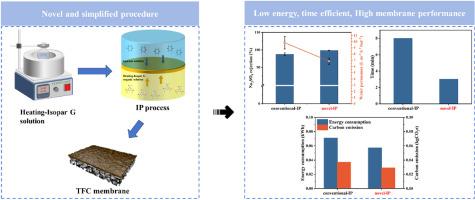Integrating heat curing and interfacial polymerization into a single process: A synergistic strategy for tailoring high-performance nanofiltration membranes
IF 9
1区 工程技术
Q1 ENGINEERING, CHEMICAL
引用次数: 0
Abstract
Interfacial polymerization (IP) is a widely adopted method for fabricating thin-film composite (TFC) nanofiltration (NF) membranes due to its advantages in achieving rapid reaction kinetics and precise control over active layer formation. However, conventional IP processes are plagued by high energy consumption, prolonged processing times, and significant carbon footprints. To address these challenges, this study introduces a novel IP strategy that replaces traditional oven curing with direct heating of the organic phase during the polymerization process. Compared to conventional TFC-O membranes prepared via standard IP, the novel TFC-T membranes exhibit enhanced crosslinking density, superior hydrophilicity, and elevated negative surface charge. The optimized TFC-T membranes demonstrated excellent rejection of common pharmaceutical contaminants (e.g., ciprofloxacin and tetracycline), and robust purification capability for surface water. Critically, this novel IP process could reduce reaction time, energy consumption, thus slashing carbon emissions compared to conventional methods. The proposed novel IP provides a scalable pathway toward carbon-neutral water treatment technologies while maintaining high-performance separation characteristics, bridging theoretical innovation and industrial feasibility in membrane science.

将热固化和界面聚合集成到一个过程中:定制高性能纳滤膜的协同策略
界面聚合(IP)是一种广泛采用的制备薄膜复合(TFC)纳滤(NF)膜的方法,因为它具有快速反应动力学和精确控制活性层形成的优点。然而,传统的IP工艺受到高能耗、长时间处理和大量碳足迹的困扰。为了解决这些挑战,本研究引入了一种新的IP策略,在聚合过程中用有机相的直接加热取代传统的烘箱固化。与通过标准IP制备的传统TFC-O膜相比,新型TFC-T膜具有增强的交联密度,优越的亲水性和更高的表面负电荷。优化后的TFC-T膜对常见的药物污染物(如环丙沙星和四环素)具有良好的抑制作用,对地表水具有强大的净化能力。关键是,与传统方法相比,这种新型IP工艺可以减少反应时间和能耗,从而减少碳排放。提出的新型IP为碳中性水处理技术提供了可扩展的途径,同时保持了高性能的分离特性,连接了膜科学的理论创新和工业可行性。
本文章由计算机程序翻译,如有差异,请以英文原文为准。
求助全文
约1分钟内获得全文
求助全文
来源期刊

Journal of Membrane Science
工程技术-高分子科学
CiteScore
17.10
自引率
17.90%
发文量
1031
审稿时长
2.5 months
期刊介绍:
The Journal of Membrane Science is a publication that focuses on membrane systems and is aimed at academic and industrial chemists, chemical engineers, materials scientists, and membranologists. It publishes original research and reviews on various aspects of membrane transport, membrane formation/structure, fouling, module/process design, and processes/applications. The journal primarily focuses on the structure, function, and performance of non-biological membranes but also includes papers that relate to biological membranes. The Journal of Membrane Science publishes Full Text Papers, State-of-the-Art Reviews, Letters to the Editor, and Perspectives.
 求助内容:
求助内容: 应助结果提醒方式:
应助结果提醒方式:


